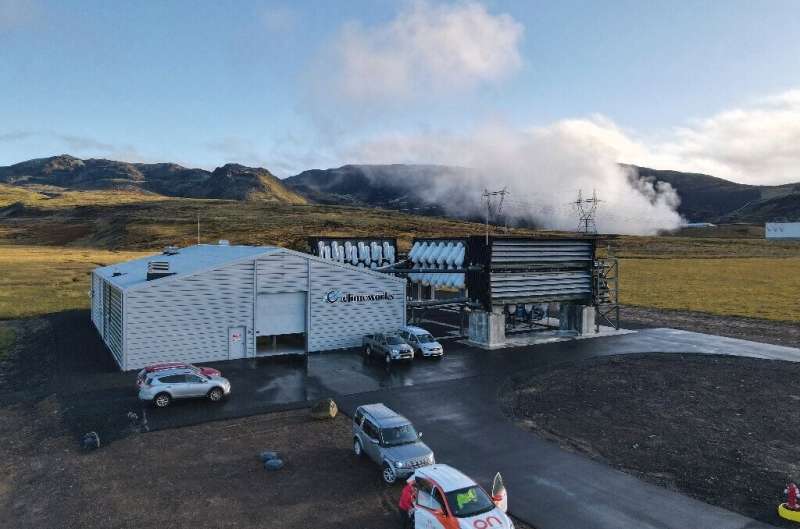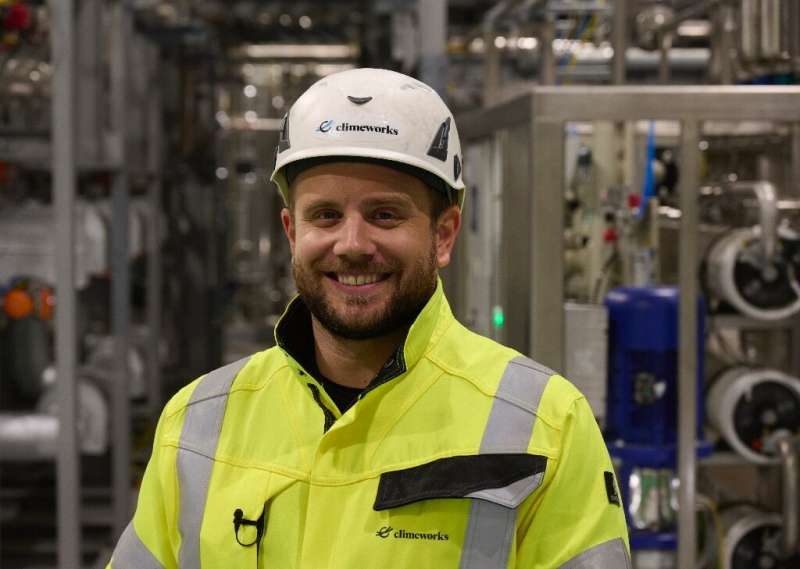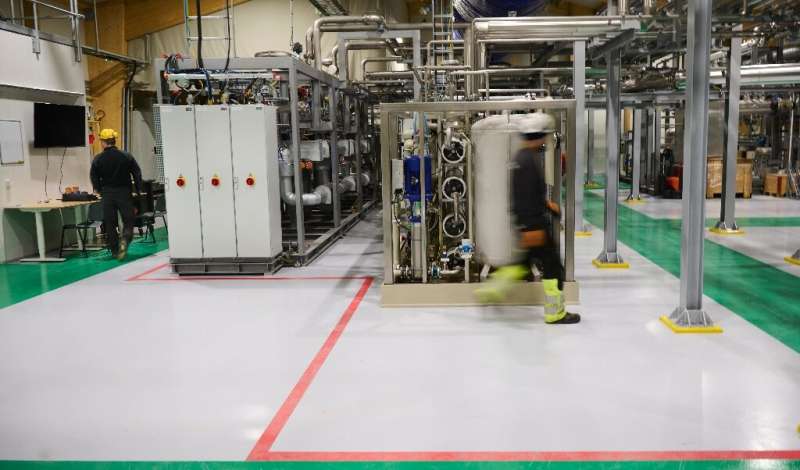In Iceland, CO2 sucked from the air is turned to rock

At the foot of an Icelandic volcano, a newly-opened plant is sucking carbon dioxide from the air and turning it to rock, locking away the main culprit behind global warming.
Orca, based on the Icelandic word for "energy," does its cutting-edge work at the Hellisheidi geothermal power plant in southwest Iceland.
It is the world's largest plant using the direct air capture technology (DAC) increasingly lighting up the imagination as the world struggles to avert catastrophic global warming.
Yet DAC is the least developed of the carbon removal technologies promoted as the key to compensating for the slow switch away from fossil fuels.
Climeworks, a Swiss start-up that has just built the plant around 30 kilometres from the capital Reykjavik in a tie-up with Icelandic companies, is not deterred.
"You have to learn to walk before you can run," said Julie Gosalvez, in charge of marketing for the company.
Her firm works with Iceland's Carbfix, which has pioneered underground carbon storage, and ON Power, a local geothermal electricity provider.
The enterprise uses Carbfix's method that mimics, in accelerated format, a natural process that can take hundreds of thousands of years.
By pulling CO2 from ambient air, the plant is different from more traditional types of carbon capture and storage (CCS) projects at highly-polluting industrial smokestacks.
The giant steel structure resting on cement slabs and linked to a maze of pipes is powered by the nearby geothermal power plant.
The facility is made of eight containers similar to those used in maritime transport, stacked up in pairs.
Fans in front of the collector draw in ambient air and release it, largely purified of CO2, through ventilators at the back.
Project manager Lukas Kaufmann said "very selective filter material inside our collector containers" catch carbon dioxide.

Turned to rock
"As soon as the filter is full, we close it off, and then we heat it up to around 100 degrees Celsius" to separate the pure gas, Kaufmann added.
Once free of impurities after treatment in the adjoining process hall, the carbon dioxide is then piped underground a distance of three kilometres (1.8 miles) to an area where grey, igloo-shaped domes dot a lunar-like landscape.
Dissolved in fresh water, the gas is then injected under high pressure into the basalt rock between 800 and 2,000 metres underground.
The solution fills the rock's cavities and the solidification process begins—a chemical reaction turning it to calcified white crystals that occurs when the gas comes in contact with the calcium, magnesium and iron in the basalt.
It takes up to two years for the CO2 to petrify.
Carbfix insists the method is the safest and most stable to stock carbon for now.
The carbon dioxide would only be re-released into the air if the rock were to heat up to very high temperatures, as in a volcanic eruption, Didier Dalmazzone, head of the chemistry laboratory at French engineering school ENSTA Paris, told AFP.
The volcanic activity level here is considered low, with the last eruption 1,900 years ago.
The Orca plant, which cost $10-15 million to build, can suck up around 4,000 tonnes of CO2 per year.
The amount is tiny by global standards. Climate modelling suggests the world needs to eliminate several billion tonnes per year by 2050.
Costly process
CCS is one of the methods advocated by experts to limit global warming to 1.5 degrees C from pre-industrial levels by 2100.
That is the bar seen as the only way to prevent catastrophic global warming.

Other CCS methods capture CO2 before it enters the atmosphere, pulling it immediately from highly-concentrated industrial pollution zones.
But the direct air capture (DAC) process, like the one in Iceland, aims to capture past emissions already in the atmosphere.
A large share of CO2 emissions is diffuse and can't be captured immediately at the source, such as those from planes, cars and ships.
However, the DAC method is in its early days and is hampered by the small concentration of CO2 in the atmosphere.
While the world's global CO2 concentration beat a new alarming record in 2020, it represents just a tiny amount of the total air, at 0.041 percent.
Orca has to process two million cubic metres of air to capture just one tonne of CO2—a costly process that requires large amounts of energy, though Climeworks would not divulge any details.
According to Dalmazzone, one option would be to capture just two-thirds of the CO2 in the air.
"That could be less costly and would be good enough, because the aim is to remove some carbon dioxide from the air, not all the CO2."
Iceland is an ideal place to use the technique, with its abundance of water and 70 percent of its primary energy coming from geothermal sources.
But the method may not be viable everywhere.
Carbfix therefore plans to test injecting salt water to see if the method can be adapted.
Meanwhile, a carbon transfer and storage hub will soon open in Straumsvik Bay, on the outskirts of the capital Reykjavik.
Dubbed Coda Terminal, it will process carbon captured at industrial sites in Northern Europe and shipped to Iceland for storage.
A first operations vessel is expected to be able to process 300,000 tonnes of CO2 per year by 2025, with a goal of 10 times more in 2030.
© 2021 AFP
















